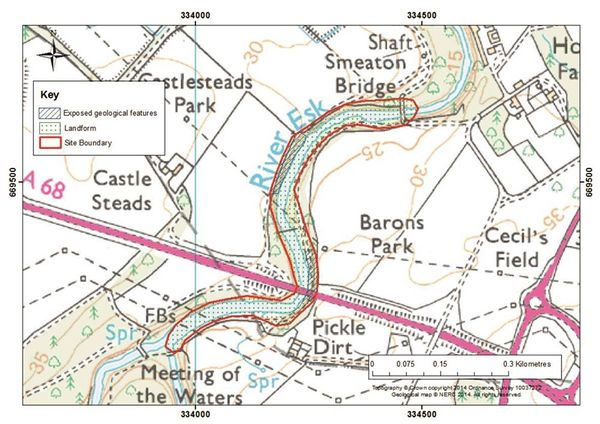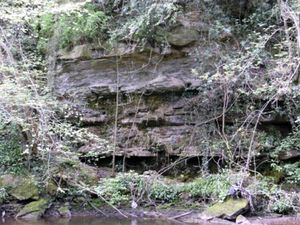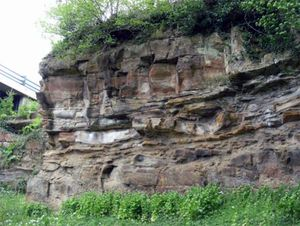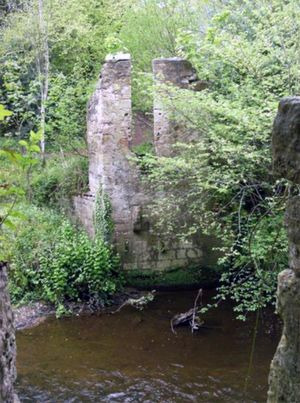Background
Within East Lothian the River Esk flows from the council boundary just past the A68 and reaches the Firth of Forth at Musselburgh. This locality is the best exposure of the Middle Coal Measures Formation within East Lothian. The surrounding area has been mined for coal and Smeaton Colliery was located a few hundred metres to the south-west of this site in 1854. Also locally there was the Smeaton Brick and Tile Works which exploited the local clay, sand and coal deposits.
Sedimentary Rocks
The Middle Coal Measures Formation is a cyclic sequence of white, grey and brown sandstone and siltstone with dark grey mudstone and coals and seatearths. The sandstone and softer siltstone and mudstone are exposed in cliff sections along the west bank of the River Esk(ELC_17_P1). The sandstone is locally channelized (erosional base; ELC_17_P2), and the contact between the sandstone and underlying mudstone/siltstone is a sharp and erosive indicating high energy deposition in streams. In channel sandstones exposed on the east bank of the River Esk a layer of large carbonised wood and plant fragments can be seen at the base of the unit indicating that during flood flows, the channels carried woody debris and deposited it within the channel sediments (ELC_17_P5). Below the sandstone is a coal layer approximately 20 cm thick (ELC_17_P6).
Igneous Rocks
The Port Seton-Spittal Dyke is exposed in this site at Black Rocks to the west of Cockenzie Harbour, and also to the east at Cockenzie old harbour at Bell’s Rocks (ELC_16 P9). The quartz dolerite dyke trends east west and is black in colour with a blocky appearance. Bands of coarser grained crystals can be seen within the rock indicating flow of the magma during dyke emplacement. The rock is fractured with mineralised veins and the larger of these fractures trend north-east to south-west. The dyke intruded into the surrounding sedimentary rocks and its contact with the Upper Limestone Formation can be best seen at Cockenzie old harbour. Here the quartz-dolerite is glassy in appearance, with numerous veins. The adjacent sandstone is hard and red with little structure which may indicate baking of the margin as the dyke was intruded (ELC_16 P10).
Access and Additional Information
Access to the River Esk at this locality can be made by parking within the village of Smeaton and crossing the A6094 at Smeaton Lodge. The road can then be followed down to Smeaton Bridge. Even though this is a private estate the area appears used by local dog walkers. A bridle path runs from Smeaton Bridge on the east side of the river to Pickle Dirt on the south side of the A68. The path is a pleasant walk giving access to exposures on the east bank of the River Esk and views to the exposures on the west bank of the River Esk. Two footbridges are marked on the 1:10 000 OS map but neither of these still cross the river, (ELC_17_P9), therefore not giving access to the west bank of the river or offering a circular route.
| 








